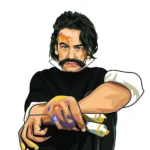Hommage au Connétable de Bourbon, auteur du sac de Rome (1959)
Note: This exceptional document was edited with the many rushes of a film reel recently found in the archives of Georges Mathieu. We have tried to reorder them chronologically as precisely as possible. All the raw footage is included, showing many actions from different angles.
On 2 April 1959, on the stage of the Fleischmarkt Theater, an avant-garde theatre in Vienna, home of the Viennese Actionists, Mathieu painted Hommage au Connétable de Bourbon. For 40 minutes, the Artist was totally engrossed in the creation of this work to the electro-acoustic music of Pierre Henry.
He was dressed in a partly open white shirt over black trousers:
“For me the clothes I wear are a form of magic. They help me to better prepare myself for the atmosphere of the process of painting and to adapt. In my view, painting is a moment which approaches the idea of a holy ritual. One can even say — for this is done in certain societies, or other civilizations — lending this act a solemnity whereby, for the occasion, new or specific clothes would be worn.”
Georges Mathieu faced this vast canvas measuring 250 x 600cm.
The public looked on mesmerized by the vision of this man, silent in front of this white screen:
“I started by painting flat on the stage floor. After about 20 minutes, the audience became restless as they could see nothing other than me dumping colours onto the canvas. Pierre Henry thought they didn’t like his music and angrily asked everyone to be quiet, even threatening to stop his concert. The audience quietened down, and I continued painting with my canvas now upright.”
As usual, when he painted these enormous canvasses called Batailles (“Battles”) he soon covered himself with polychrome spots, splashes, squirts, drippings. Possessed by this mad creativity and guided by his intuition and momentum, he used to seek out the paint strokes to the rhythm of the music, using paint brushes and colours, without any preconceptions and with totally free movements. In a state of trance, he would leap up, reverse, move forward, with a long brush in his hand, sometimes seizing a tube of painting, which he would then crush, enraged, onto the canvas:
“I paint quickly because it’s my rhythm.”
“I give it everything I’ve got.”
On the canvas, the sky has darkened, there is a clear opening patch to the right. One can imagine the sound of swords crossing, Charles V’s horsemen fighting off the Romans in a mighty and bloody combat. The Artist continues to splash himself with his paint. His face and hands express the intensity of his Artistic process. He wipes his spotted face with oil. Then kneels down on the ground, contemplates his work and, standing up again, leaps at the canvas to bring some finishing touches. Extenuated and emptied, he sits down, pensive, at the end of the execution of his masterpiece.
“I am what I paint.”
“I feel that my painting is completed when this inner need becomes manifest, or when the vitality of this process has reached its peak with a minimum of gestures or brush strokes”.
“The Connétable de Bourbon, as we know, was the Commander of the sack of Rome. He drove out the Pope and all the Artists working there at the time. I wanted to express a form of celebration of his kicking out all those painters of the classical school. It was thanks to these spectacular measures, that baroque and later modern painting made their appearance.”
Hommage au Connétable de Bourbon, is “the marriage of concrete music and abstract art”. For Francois Mathey, “Mathieu adores large formats. He is particularly comfortable with them and he appreciates the resources of this painting strategy. He measures up the canvas, measures himself to the painting, surveys the scene of his battle…”
This piece is without doubt one of the masterpieces of the Artist.
— The foregoing was first published in the Applicat-Prazan catalogue printed for the exhibition of Hommage au Connétable de Bourbon at Art Basel Unlimited in June 2018.
— Video © Comité Georges Mathieu / ADAGP





